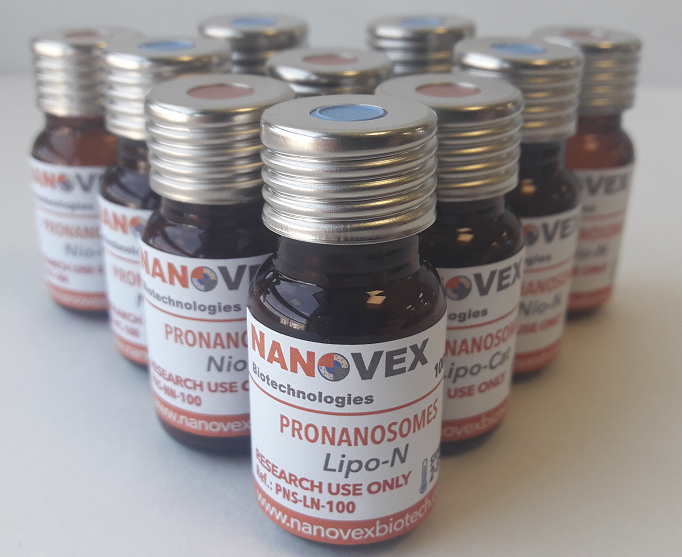The aim of this post is to explain how to choose the appropriate nanovesicle regarding its final application. Although nanovesicles have a lot of different applications, here we will discuss the most common:
- Intracellular delivery
- Controlled delivery
- In vitro assays
- In vivo assays
- Passive targeting
- Active targeting
- Gene delivery
- Diagnostics
- Theranostic
- Functional Foods and Nutraceuticals
- (Trans)dermal delivery
- Vaccine
It is important to highlight that the intended application could entail simultaneously several of the above mentioned applications. For instance, an in vivo assay could be performed to intracellular delivery, based on active targeting, as well as to bioimaging (diagnostics) purposes. Consequently, nanovesicles having different properties are an interesting tool and for this reason our PRONANOSOMES(ready-to-use products to obtain in a fast and easy way nanovesicles to encapsulate compounds) are able to present different characteristics simultaneously (i.e: cationic, pegylated, bioconjugable and fluorescent for the above mentioned example).
INTRACELLULAR DELIVERY
Cationic nanovesicles improve intracellular delivery of compounds therefore we recommend PRONANOSOME Lipo-cat to obtain cationic liposomes or PRONANOSOME Nio-cat for cationic niosomes.
CONTROLLED DELIVERY
Delivery of the encapsulated compound can be controlled by external parameters such as temperature or pH. In order to release the nanovesicles content at certain temperature, a thermosentitive nanovesicle is necessary. We recommend PRONANOSOME Thermo which is able to release the content at 42ºC. In addition, to control the delivery with pH, a pH sensitive nanovesicles is requiered, such as PRONANOSOME pH which is able to release its content at pH=5.
IN VITRO ASSAYS
One of the most important aspects to carry out in vitro assays is to use a low cytotoxicity nanovesicle system. Regarding this aspect, all of our Pronanosomes has been tested in vitro showing a negligible cytotoxicity.
IN VIVO ASSAYS
On in vivo assays, nanovesicles are rapidly captured by the Mononuclear Phagocyte System (MPS) and removed from the blood circulation. In order to avoid capturing by MPS and to prolong circulation times of nanovesicles in blood, pegylated nanovesicles are employed. PRONANOSOME PEGYLATED SERIES allow obtaining pegylated nanovesicles, also called long-circulation or stealth nanovesicles which are accumulated in the tumor tissue due to the Enhanced Permeation and Retention effect (EPR).
PASSIVE TARGETING
Passive targeting is based on the longevity of the nanovesicles in the blood and its accumulation in pathological sites (EPR effect-mediated). Since passive targeting involves an in vivo assay, we recommend to employ PRONANOSOME PEGYLATED SERIES. Morover, depending on the release method, other characteristics could be selected such as controlled delivery with pH PRONASOME pH(PRONANOSOME pH PEG for pH sensitive and pegylated liposomes)
ACTIVE TARGETING
Actively targeted nanovesicles systems are prepared by conjugating small-molecule ligands, peptides and monoclonal antibodies, among others, on the nanovesicle surface. PRONANOSOME BIOCONJUGABLE SERIES are nanovesicles ready to be conjugated.
As active targeting involves (in most cases) an in vivo assay, we also recommend PRONANOSOME PEGYLATED SERIES, therefore the best system is PRONANOSOME BIOCONJUGABLE AND PEGYLATED SERIES.
Other alternative is to use Folic Acid (F.A.) surface modification (PRONANOSOME FA SERIES), using folate receptors (FR) overexpressed in tumors.
GENE DELIVERY
Direct gene transfer for the treatment of human diseases requires a vector which can be administered efficiently, safely and repeatedly. Nanovesicles represent one of the few examples that can meet these requirements. Our TRANSFECTOSOMES form stable complex nanovesicles with DNA/RNA and rapidly release the DNA/RNA into the cells by endocytosis.
DIAGNOSTICS
Nanovesicles can be employed as diagnostic tools using different strategies such as:
- Carrying diagnostic agents in all imaging modalities.
- Amplification of signal in immunoassays using nanovesicles containing labels or using nanovesicle-nanoparticle hybrids.
Fluorescent labelled and bioconjugable PRONANOSOMES (PRONANOSOME BIOCONJUGABLE, (PEGYLATED) AND FLUORESCENT SERIES)are very useful as diagnostic tool. On the other hand, PRONANOSOME BIOCONJUGABLE SERIES can encapsulate a wide range of compounds in order to improve the detection amplifying the signal in the immunoassays.
THERANOSTICS
Theranostics is the combination of therapeutic and diagnostic agents on a single platform. Nanovesicles containing drugs and a strong fluorescence property can be used for bio-imaging and for the treatment of diseases simultaneously.
Our PRONANOSOME BIOCONJUGABLE, (PEGYLATED) AND FLUORESCENT SERIES are able to:
- Encapsulate a wide range of drugs for the treatment of diseases (active targeting).
- Be used for diagnostics (bio-imaging) due to their strong fluorescence.
- Be targeted to a specific tissue due to biorecognition.
FUNCTIONAL FOODS AND NUTRACEUTICALS
Nanovesicles are delivery vehicles used in food applications to stabilize and protect compounds as well as improve their bioavailability and mask undesired tastes.
Liposomes (PRONANOSOME LIPO-N) and niosomes (PRONANOSOME NIO-N) are the most common nanovesicles in food applications since these nanovesicles are highly biocompatible and biodegradable.
(TRANS)DERMAL DELIVERY
Nanovesicles are commonly used in dermal applications since they are able to vehiculate compounds into deeper skin layers. Dermal targeting and/or transdermal delivery of a drug are the strategies most used employing nanovesicles.
Liposomes (PRONANOSOME LIPO-N) have been the most employed systems in this field, although Nanovex Biotechnologies is developing a specific PRONANOSOME for these purposes.
VACCINE
One of the major limitations of nanovesicles administered intravenously is rapid clearance by the MPS if the nanovesicle is not pegylated. While this phenomenon is undesirable in drug delivery (active or passive targeting), it could be useful for vaccine delivery. This observation prompted great interest in the development of macrophage-targeted delivery of vaccines using nanovesicles.
Cationic liposomes (PRONANOSOME LIPO-CAT) is the most employed system for macrophage targeted delivery of vaccines due to their characteristics:
- The particulate nature of liposomes helps in cross-presentation of antigens that generate antigen-specific cytotoxic T cell responses (CTL), which is particularly important in the development of vaccines against viruses and cancer
- Liposomes improve the stability of antigens against physical and biological degradation (enzymatic breakdown of peptide/protein antigens)
Originally posted on 15th of March 2017: http://www.nanovexbiotech.com/choose-appropriate-nanovesicle/
Nanovex Biotechnologies is distributed by Caltag medsystems, to see more click here.

